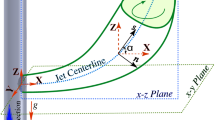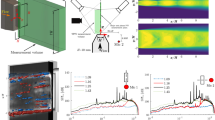Abstract
High Reynolds number, low Mach number, turbulent shear flow past a rectangular, shallow cavity has been experimentally investigated with the use of dual-camera cinematographic particle image velocimetry (CPIV). The CPIV had a 3 kHz sampling rate, which was sufficient to monitor the time evolution of large-scale vortices as they formed, evolved downstream and impinged on the downstream cavity wall. The time-averaged flow properties (velocity and vorticity fields, streamwise velocity profiles and momentum and vorticity thickness) were in agreement with previous cavity flow studies under similar operating conditions. The time-resolved results show that the separated shear layer quickly rolled-up and formed eddies immediately downstream of the separation point. The vortices convect downstream at approximately half the free-stream speed. Vorticity strength intermittency as the structures approach the downstream edge suggests an increase in the three-dimensionality of the flow. Time-resolved correlations reveal that the in-plane coherence of the vortices decays within 2–3 structure diameters, and quasi-periodic flow features are present with a vortex passage frequency of ~1 kHz. The power spectra of the vertical velocity fluctuations within the shear layer revealed a peak at a non-dimensional frequency corresponding to that predicted using linear, inviscid instability theory.











Similar content being viewed by others
References
Ahuja KK, Mendoza J (1995) Effects of cavity dimensions, boundary layer, and temperature on cavity noise with emphasis on benchmark data to validate computational aeracoustic codes. NASA report CR-4653
Ashcroft G, Zhang X (2005) Vortical structures over rectangular cavities at low speed. Phys Fluid 17:015104-1–015104-8
Bian S (2007) Kilohertz cinematographic particle image velocimetry measurements of turbulent flow past a shallow cavity. PhD thesis, University of Michigan, Ann Arbor
Bian S, Ceccio SL, Driscoll JF (2010) A dual-camera cinematographic PIV measurement system at kilohertz frame rate for high speed, unsteady flows. Exp Fluids 48(3):487–495
Chang K, Constantinescu G, Park S (2006) Analysis of the flow and mass transfer processes for the incompressible flow past an open cavity with a laminar and a fully turbulent incoming boundary layer. J Fluid Mech 561:113–145
Chatellier L, Laumoinier J, Gervais Y (2004) Theoretical and experimental investigations of low Mach number turbulent cavity flows. Exp Fluids 36:728–740
Dimotakis PE (1986) Two-dimensional shear-layer entrainment. AIAA J 24:1791–1796
Forestier N, Jacquin L, Geffroy P (2003) The mixing layer over a deep cavity at high-subsonic speed. J Fluid Mech 475:101–145
Gharib M (1987) Response of the cavity shear layer oscillations to external forcing. AIAA J 25(1):43–47
Haigermoser C (2009) Application of an acoustic analogy to PIV data from rectangular cavity flows. Exp Fluids 47:145–157
Haigermoser C, Vesely L, Novara M, Onorato M (2008) A time-resolved particle image velocimetry investigation of a cavity flow with a tick incoming turbulent boundary layer. Phys Fluids 20:105101-1–105101-14
Heller SS, Bliss DB (1975) The physical mechanism of flow induced pressure fluctuations in cavities and concepts for their suppression. AIAA Paper No. 75–491. AIAA, Washington, DC
Ho C-M, Huang LS (1982) Subharmonics and vortex merging in mixing layers. J Fluid Mech 119:443–473
Ho C-M, Huerre P (1984) Perturbed free shear layers. Annu Rev Fluid Mech 16:365–424
Howe MS (1997) Edge, cavity and aperture tones at very low Mach numbers. J Fluid Mech 330:61–84
Knisely C, Rockwell D (1982) Self-sustained low-frequency components in an impinging shear layer. J Fluid Mech 116:157–186
Larcheveque L, Sagaut P, Mary I, Labbe O (2003) Large-eddy simulation of a compressible flow past a deep cavity. Phys Fluid 15(1):193–210
Lin JC, Rockwell D (2001) Organized oscillations of initially turbulent flow past a cavity. AIAA J 39(6):1139–1151
Marusic I, McKeon BJ, Monkewitz PA, Nagib HM, Smits AJ, Sreenivasan KR (2010) Wall-bounded turbulent flows at high Reynolds numbers: Recent advances and key issues. Phys Fluids 22:065103-1–065103-24
Moore DW, Saffman PG (1975) The density of organized vortices in a turbulent mixing layer. J Fluid Mech 69:465–473
Oweis GF, Choi J, Ceccio SL (2004) Dynamics and noise emission of laser induced cavitation bubbles in a vertical flow field. J Acoust Soc Am 115(3):1049–1058
Pereira JCF, Sousa JMM (1995) Experimental and numerical investigation of flow oscillations in a rectangular cavity. J Fluid Eng 117:68–74
Raffel M, Willert CE, Kompenhans J (1998) Particle image velocimetry: a practical guide, 1st edn. Springer, New York
Rockwell D (1977) Prediction of oscillation frequencies for unstable flow past cavities. J Fluid Eng 99:294–300
Rockwell D (1998) Vortex-body interactions. Ann Rev Fluid Mech 30:199–229
Rockwell D, Knisely C (1979) The organized nature of flow impingement upon a corner. J Fluid Mech 93:413–432
Rockwell D, Naudascher E (1978) Review-self-sustaining oscillations of flow past cavities. J Fluid Eng 100:152–165
Rockwell D, Naudascher E (1979) Self-sustained oscillations of impinging free shear layers. Ann Rev Fluid Mech 11:67–94
Rossiter JE (1964) Wind tunnel experiments on the flow over rectangular cavities at subsonic and transonic speeds. Aeronautical Research Council Reports and Memoranda No. 3438
Rowley CW, Colonius T, Basu AJ (2002) On self-sustained oscillations in two-dimensional compressible flow over rectangular cavities. J Fluid Mech 455:315–346
Sarohia V (1977) Experimental investigation of oscillations in flows over shallow cavities. AIAA J 15(7):984–991
Zhou J, Adrian RJ, Balachandar S, Kendall TM (1999) Mechanisms for generating coherent packets of hairpin vortices in channel flow. J Fluid Mech 387:353–396
Acknowledgments
This work was partially supported by the National Science Foundation under project number NSF-CTM-02-03140.
Author information
Authors and Affiliations
Corresponding author
About this article
Cite this article
Bian, S., Driscoll, J.F., Elbing, B.R. et al. Time resolved flow-field measurements of a turbulent mixing layer over a rectangular cavity. Exp Fluids 51, 51–63 (2011). https://doi.org/10.1007/s00348-010-1025-7
Received:
Revised:
Accepted:
Published:
Issue Date:
DOI: https://doi.org/10.1007/s00348-010-1025-7




